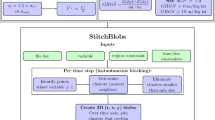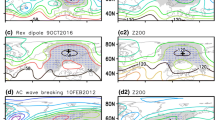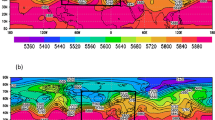Abstract
There is urgent need for a consistent blocking identification method that can be used and compared across reanalyses, models and climate scenarios. We present such a method and diagnose daily blocking frequency in 43 years (1958–2000) of ERA-40 Reanalysis for indices defined on both the commonly used geopotential height and potential temperature fields as well as a zonal wind index. Applications of various blocking indices to the same data highlights the importance of a consistent methodology for comparison and a method that identifies blocks along a path that varies with the latitude of the storm track. Since the method accommodates blocking detection using 500 mb zonal-wind which is readily available in climate model output, we diagnose blocking in 14 CMIP3 models under two different greenhouse gas scenarios. Blocking duration remains nearly constant among the scenarios, but a robust reduction in blocking frequency with global warming is demonstrated.













Similar content being viewed by others
References
Barnes EA, Hartmann DL (2010) Influence of eddy-driven jet latitude on North Atlantic jet persistence and blocking frequency in CMIP3 integrations. Geophys Res Lett 37. doi:10.1029/2010GL045700
Barriopedro D, Garcia-Herrera R, Gonzalex-Rouco J (2010a) Application of blocking diagnosis methods to general circulation models. Part I: a novel detection scheme. Clim Dynam. doi:10.1007/s00382-010-0766-6
Barriopedro D, Garcia-Herrera R, Gonzalex-Rouco J (2010b) Application of blocking diagnosis methods to general circulation Models. Part II: model simulations. Clim Dynam doi:10.1007/s00382-010-0767-5
Barriopedro D, Garcia-Herrera R, Huth R (2008) Solar modulation of Northern Hemisphere winter blocking. J Geophys Res 113:D14118. doi:10.1029/2008JD009789
Barriopedro D, Garcia-Herrera R, Lupo AR, Hernandez E (2006) A climatology of Northern Hemisphere blocking. J Clim 19:1042–1063
Bengtsson L, Hodges KI, Roeckner E (2006) Storm tracks and climate change. J Clim 19:3518–3543
Berrisford P, Hoskins BJ, Tyrlis E (2007) Blocking and Rossby wave breaking on the dynamical tropopause in the Southern Hemisphere. J Atmos Sci 64:2881–2898
Black E, Blackburn M, Harrison G, Hoskins B, Methven J (2004) Factors contributing to the summer 2003 European heatwave. Weather 17:4080–4088
Croci-Maspoli M, Schwierz C, Davies HC (2007) A multifaceted climatology of atmospheric blocking and its recent linear trend. J Clim 20:633–649
D’Andrea F et al (1998) Northern Hemisphere atmospheric blocking as simulated by 15 atmospheric general circulation models in the period 1979–1988. Clim Dynam 14:385–407
Delworth T et al (2006) GFDL’s CM2 global coupled climate models—Part 1: formulation and simulation characteristics. J Clim 19:643–674
Dole R et al (2011) Was there a basis for anticipating the 2010 Russian heat wave? Geophys Res Lett 38. doi:10.1029/2010GL046582
Dole RM, Gordon ND (1983) Persistent anomalies of the extratropical Northern Hemisphere winter time circulation: geographical distribution and regional persistence characteristics. Mon Wea Rev 111:1567–1586
Dong L, Vogelsang TJ, Colucci SJ (2008) Interdecadal trend and ENSO-related interannual variability in Southern Hemisphere blocking. J Clim 21:3068–3077
Fowler D et al (2008) Ground-level ozone in the 21st century: future trends, impacts and policy implications. Tech Rep R Soc
Frankze C, Woollings T (2010) On the perisistence and predictability properties of North Atlantic climate variability. J Clim (accepted)
Hamming RW (1989) Digital filters. Prentice Hall, Upper Saddle River
Hartmann DL, Wallace JM, Thompson VLDWJ, Holton JR (2000) Can ozone depletion and global warming interact to produce rapid climate change? Proc Natl Acad Sci (USA) 97:1412–1417
Hinton TJ, Hoskins BJ, Martin GM (2009) The influence of tropical sea surface temperatures and precipitation on north Pacific atmospheric blocking. Clim Dynam 33:549–563. doi:10.1007/s00382-009-0542-7
Hoskins BJ, James IN, White GH (1983) The shape, propagation and mean-flow interaction of large-scale weather systems. J Atmos Sci 40:1595
Ioannidou L, Yau MK (2008) A climatology of the Northern Hemisphere winter anticyclones. J Geophys Res 113:D08119. doi:10.1029/2007JD008409
Lejanäs H, Økland H (1983) Characteristics of Northern Hemisphere blocking as determined from a long series of observational data. Tellus 35:350–362
Masato G, Hoskins BJ, Woolings TJ (2009) Can the frequency of blocking be described by a red noise process? JAS 66:2143–2149
Matsueda M (2011) Predicability of Euro-Russian blocking in summer 2010. Geophys Res Lett 38. doi:10.1029/2010GL046557
Matsueda M, Mizuta R, Kusunoki S (2009) Future change in wintertime atmospheric blocking simulated using a 20-km-mesh atmospheric global circulation model. J Geophys Res 114:D12114. doi:10.1029/2009JD011919
Meehl GA, Covey C, Delworth T, Latif M, McAvaney B, Mitchell JFB, Stouffer RJ, Taylor KE (2007) The WRCP CMIP3 multi-model dataset: a new era in climate change research. Bull Amer Meteor Soc 88:1383–1394
Meehl GA et al (2007b) Global climate projections. Climate change 2007: the physical science basis. Contribution of working group I to the fourth assessment report of the intergovernmental panel on climate change, Cambridge University Press, Cambridge
Miller RL, Schmidt GA, Shindell DT (2006) Forced annular variations in the 20th century intergovernmental panel on climate change fourth assessment report models. J Geophys Res 111. doi:10.1029/2005JD006323
Nakamura H, Nakamura M, Anderson JL (1997) The role of high- and low-frequency dynamics in blocking formation. Mon Wea Rev 125:2074–2093
Pelly JL, Hoskins BJ (2003) A new perspective on blocking. J Atmos Sci 60:743–755
Pinto JG, Ulbrich U, Leckebusch GC, Spangehl T, Reyers M, Zacharias S (2007) Changes in storm track and cyclone activity in three SRES ensemble experiments with the ECHAM5/MIP-OM1 GCM. Clim Dynam 29:195–210
Ringer MA et al (2006) The physical properties of the atmosphere in the new Hadley Centre Global Environmental Model (HadGEM1). Part II: aspects of variability and regional climate. J Clim 19:1302
Scaife A et al (2011) Improved Atlantic blocking in a climate model. Geophys Res Lett (submitted)
Scaife AA, Woollings T, Knight J, Martin G, Hinto T (2010) Atmospheric blocking and mean biases in climate models. J Clim 23:6143–6152
Schwierz C, Croci-Maspoli M, Davies HC (2004) Perspicacious indicators of atmospheric blocking. Geophys Res Lett 31 doi:10.1029/2003GL019341
Sillmann J, Croci-Maspoli M (2009) Present and future atmospheric blocking and its impacts on European mean and extreme climate. Geophys Res Lett 36:L10702. doi:10.1029/2009GL038259
Tibaldi S, Molteni F (1990) On the operational predictability of blocking. Tellus 42:343–365
Tyrlis E, Hoskins BJ (2008) Aspects of Northern Hemisphere atmospheric blocking climatology. J Atmos Sci 65:1638–1652
Tyrlis E, Hoskins BJ (2008) The morphology of Northern Hemisphere blocking. J Atmos Sci 65:1653–1665
Uppala SM et al (2005) The ERA-40 reanalysis. Quart J R Meteor Soc 131:2961–3012
Waston JS, Colucci SJ (2002) Evaluation of ensemble predictions of blocking in the NCEP global spectral model. Mon Wea Rev 130:3008–3021
Woollings T (2010) Dynamical influences on European climate: an uncertain future. Philos Trans R Soc Lond A 368:3733–3756
Woollings T, Hannachi A, Hoskins B, Turner A (2010) A regime view of the North Atlantic Oscillation and its response to anthropogenic forcing. J Clim 23:1291–1307
Woollings T, Hoskins B, Blackburn M, Berrisford P (2008) A new Rossby wave-breaking interpretation of the North Atlantic Oscillation. J Atmos Sci 65:609–626
Yin JH (2005) A consistent poleward shift of the storm tracks in simulations of 21st century climate. Geophys Res Lett 32. doi:10.1029/2005GL023684
Acknowledgments
We are indebted to ECMWF for providing the ERA-40. This work was supported by the STC program of the National Science Foundation via the National Center for Earth-surface Dynamics under the agreement EAR- 0120914 and by the STC International Research Experience Program of the NSF through the Nanobiotechnology Center under Agreement ECS-9876771. This work was also supported by the Climate Dynamics Program of the National Science Foundation under grant ATM 0409075. We acknowledge the modeling groups, the Program for Climate Model Diagnosis and Intercomparison (PCMDI) and the WCRP’s Working Group on Coupled Modelling (WGCM) for their roles in making available the WCRP CMIP3 multi-model dataset. Support of this dataset is provided by the Office of Science, U.S. Department of Energy.
Author information
Authors and Affiliations
Corresponding author
Rights and permissions
About this article
Cite this article
Barnes, E.A., Slingo, J. & Woollings, T. A methodology for the comparison of blocking climatologies across indices, models and climate scenarios. Clim Dyn 38, 2467–2481 (2012). https://doi.org/10.1007/s00382-011-1243-6
Received:
Accepted:
Published:
Issue Date:
DOI: https://doi.org/10.1007/s00382-011-1243-6




